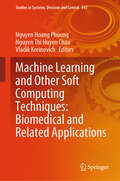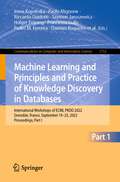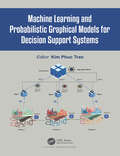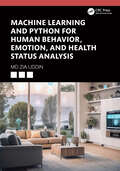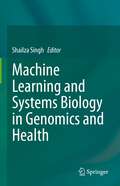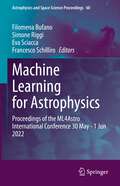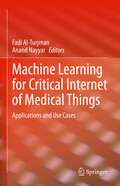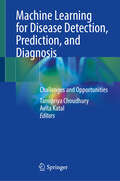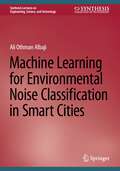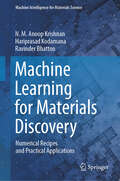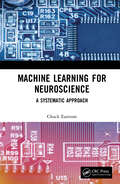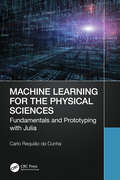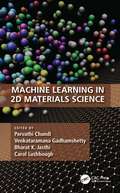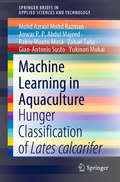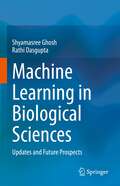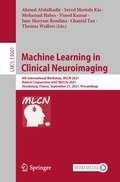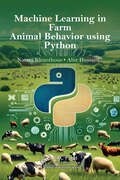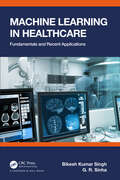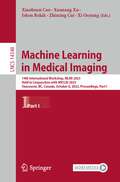- Table View
- List View
Machine Learning and Other Soft Computing Techniques: Biomedical and Related Applications (Studies in Systems, Decision and Control #543)
by Vladik Kreinovich Nguyen Hoang Phuong Nguyen Thi Huyen ChauThis book contains applications to various health-related problems, from designing and maintaining a proper diet to enhancing hygiene to analysis of mammograms and left-right brain activity to treating diseases such as diabetes and drug addictions. Health issues are very important. So naturally whatever new data processing technique appears, researchers try to apply it to health issues as well. From this viewpoint, Artificial Intelligence (AI) and Computational Intelligence (CI) techniques are no exception: they have been successfully applied to medicine, and more promising applications are on the way. Applications of AI and CI techniques to health issues are the main focus of this book. Health issues are also very delicate, because human bodies are complex organisms. No matter how interesting and promising are new ideas and new techniques, there is always a possibility of unexpected side effects. Because of this, we cannot apply untested methods to patients, and we first need to test these methods on other less critical applications. Several book chapters describe such applications—whose success paves the way for these methods to be used in biomedical situations. These applications range from human/face detection to predicting student success to predicting election results to explaining the observed intensity of space light. We hope that this book helps practitioners and researchers to learn more about computational intelligence techniques and their biomedical applications—and to further develop this important research direction.
Machine Learning and Principles and Practice of Knowledge Discovery in Databases: International Workshops Of Ecml Pkdd 2021, Virtual Event, September 13-17, 2021, Proceedings, Part I (Communications In Computer And Information Science Series #1524)
by Lee Cooper Wouter Verbeke Rita Ribeiro Annalisa Appice Elio Masciari João Gama Riccardo Guidotti Pedro M. Ferreira Albert Bifet Ricard Gavaldà Ilaria Bordino Francesco Gullo Zbigniew Ras Slawomir Nowaczyk Giovanni Ponti Sepideh Pashami Holger Fröning Franz Pernkopf Gregor Schiele Michaela Blott Lorenzo Severini Przemyslaw Biecek Irena Koprinska Ibéria Medeiros Giuseppina Andresini Naghmeh Ghazaleh Jonas Richiardi Damian Roqueiro Konstantinos Sechidis Guilherme Graça Ettore Ritacco Paolo Mignone Szymon Jaroszewicz Gaia Ceddia Francesca Naretto Andreas Theissler Ivan Luciano Danesi Diego Saldana Arif Canakoglu Sara Pido Pietro Pinoli<p>This two-volume set constitutes the refereed proceedings of the workshops which complemented the 21th Joint European Conference on Machine Learning and Knowledge Discovery in Databases, ECML PKDD, held in September 2021. Due to the COVID-19 pandemic the conference and workshops were held online.<p> <p>The 104 papers were thoroughly reviewed and selected from 180 papers submited for the workshops.<p>
Machine Learning and Principles and Practice of Knowledge Discovery in Databases: International Workshops of ECML PKDD 2022, Grenoble, France, September 19-23, 2022, Proceedings (Communications In Computer And Information Science Series #1753)
by Lee Cooper Wouter Verbeke Rita Ribeiro Annalisa Appice Elio Masciari João Gama Riccardo Guidotti Pedro M. Ferreira Albert Bifet Ricard Gavaldà Ilaria Bordino Francesco Gullo Zbigniew Ras Slawomir Nowaczyk Giovanni Ponti Sepideh Pashami Holger Fröning Franz Pernkopf Gregor Schiele Michaela Blott Lorenzo Severini Przemyslaw Biecek Irena Koprinska Ibéria Medeiros Giuseppina Andresini Naghmeh Ghazaleh Jonas Richiardi Damian Roqueiro Konstantinos Sechidis Guilherme Graça Ettore Ritacco Paolo Mignone Szymon Jaroszewicz Gaia Ceddia Francesca Naretto Andreas Theissler Ivan Luciano Danesi Diego Saldana Arif Canakoglu Sara Pido Pietro PinoliThis volume constitutes the papers of several workshops which were held in conjunction with the International Workshops of ECML PKDD 2022 on Machine Learning and Principles and Practice of Knowledge Discovery in Databases, ECML PKDD 2022, held in Grenoble, France, during September 19–23, 2022.
Machine Learning and Probabilistic Graphical Models for Decision Support Systems
by Kim Phuc TranThis book presents recent advancements in research, a review of new methods and techniques, and applications in decision support systems (DSS) with Machine Learning and Probabilistic Graphical Models, which are very effective techniques in gaining knowledge from Big Data and in interpreting decisions. It explores Bayesian network learning, Control Chart, Reinforcement Learning for multicriteria DSS, Anomaly Detection in Smart Manufacturing with Federated Learning, DSS in healthcare, DSS for supply chain management, etc. Researchers and practitioners alike will benefit from this book to enhance the understanding of machine learning, Probabilistic Graphical Models, and their uses in DSS in the context of decision making with uncertainty. The real-world case studies in various fields with guidance and recommendations for the practical applications of these studies are introduced in each chapter.
Machine Learning and Python for Human Behavior, Emotion, and Health Status Analysis
by Md Zia UddinThis book is a practical guide for individuals interested in exploring and implementing smart home applications using Python. Comprising six chapters enriched with hands-on codes, it seamlessly navigates from foundational concepts to cutting-edge technologies, balancing theoretical insights and practical coding experiences. In short, it is a gateway to the dynamic intersection of Python programming, smart home technology, and advanced machine learning applications, making it an invaluable resource for those eager to explore this rapidly growing field.Key Features: Throughout the book, practicality takes precedence, with hands-on coding examples accompanying each concept to facilitate an interactive learning journey Striking a harmonious balance between theoretical foundations and practical coding, the book caters to a diverse audience, including smart home enthusiasts and researchers The content prioritizes real-world applications, ensuring readers can immediately apply the knowledge gained to enhance smart home functionalities Covering Python basics, feature extraction, deep learning, and XAI, the book provides a comprehensive guide, offering an overall understanding of smart home applications
Machine Learning and Systems Biology in Genomics and Health
by Shailza SinghThis book discusses the application of machine learning in genomics. Machine Learning offers ample opportunities for Big Data to be assimilated and comprehended effectively using different frameworks. Stratification, diagnosis, classification and survival predictions encompass the different health care regimes representing unique challenges for data pre-processing, model training, refinement of the systems with clinical implications. The book discusses different models for in-depth analysis of different conditions. Machine Learning techniques have revolutionized genomic analysis. Different chapters of the book describe the role of Artificial Intelligence in clinical and genomic diagnostics. It discusses how systems biology is exploited in identifying the genetic markers for drug discovery and disease identification. Myriad number of diseases whether be infectious, metabolic, cancer can be dealt in effectively which combines the different omics data for precision medicine. Major breakthroughs in the field would help reflect more new innovations which are at their pinnacle stage. This book is useful for researchers in the fields of genomics, genetics, computational biology and bioinformatics.
Machine Learning and its Applications
by Peter WlodarczakIn recent years, machine learning has gained a lot of interest. Due to the advances in processor technology and the availability of large amounts of data, machine learning techniques have provided astounding results in areas such as object recognition or natural language processing. New approaches, e.g. deep learning, have provided groundbreaking outcomes in fields such as multimedia mining or voice recognition. Machine learning is now used in virtually every domain and deep learning algorithms are present in many devices such as smartphones, cars, drones, healthcare equipment, or smart home devices. The Internet, cloud computing and the Internet of Things produce a tsunami of data and machine learning provides the methods to effectively analyze the data and discover actionable knowledge. This book describes the most common machine learning techniques such as Bayesian models, support vector machines, decision tree induction, regression analysis, and recurrent and convolutional neural networks. It first gives an introduction into the principles of machine learning. It then covers the basic methods including the mathematical foundations. The biggest part of the book provides common machine learning algorithms and their applications. Finally, the book gives an outlook into some of the future developments and possible new research areas of machine learning and artificial intelligence in general. This book is meant to be an introduction into machine learning. It does not require prior knowledge in this area. It covers some of the basic mathematical principle but intends to be understandable even without a background in mathematics. It can be read chapter wise and intends to be comprehensible, even when not starting in the beginning. Finally, it also intends to be a reference book. Key Features: Describes real world problems that can be solved using Machine Learning Provides methods for directly applying Machine Learning techniques to concrete real world problems Demonstrates how to apply Machine Learning techniques using different frameworks such as TensorFlow, MALLET, R
Machine Learning for Advanced Functional Materials
by Nirav Joshi Vinod Kushvaha Priyanka MadhushriThis book presents recent advancements of machine learning methods and their applications in material science and nanotechnologies. It provides an introduction to the field and for those who wish to explore machine learning in modeling as well as conduct data analyses of material characteristics. The book discusses ways to enhance the material’s electrical and mechanical properties based on available regression methods for supervised learning and optimization of material attributes. In summary, the growing interest among academics and professionals in the field of machine learning methods in functional nanomaterials such as sensors, solar cells, and photocatalysis is the driving force for behind this book. This is a comprehensive scientific reference book on machine learning for advanced functional materials and provides an in-depth examination of recent achievements in material science by focusing on topical issues using machine learning methods.
Machine Learning for Astrophysics: Proceedings of the ML4Astro International Conference 30 May - 1 Jun 2022 (Astrophysics and Space Science Proceedings #60)
by Filomena Bufano Simone Riggi Eva Sciacca Francesco SchilliroThis book reviews the state of the art in the exploitation of machine learning techniques for the astrophysics community and gives the reader a complete overview of the field. The contributed chapters allow the reader to easily digest the material through balanced theoretical and numerical methods and tools with applications in different fields of theoretical and observational astronomy. The book helps the reader to really understand and quantify both the opportunities and limitations of using machine learning in several fields of astrophysics.
Machine Learning for Critical Internet of Medical Things: Applications and Use Cases
by Fadi Al-Turjman Anand NayyarThis book discusses the applications, challenges, and future trends of machine learning in medical domain, including both basic and advanced topics. The book presents how machine learning is helpful in smooth conduction of administrative processes in hospitals, in treating infectious diseases, and in personalized medical treatments. The authors show how machine learning can also help make fast and more accurate disease diagnoses, easily identify patients, help in new types of therapies or treatments, model small-molecule drugs in pharmaceutical sector, and help with innovations via integrated technologies such as artificial intelligence as well as deep learning. The authors show how machine learning also improves the physician’s and doctor’s medical capabilities to better diagnosis their patients. This book illustrates advanced, innovative techniques, frameworks, concepts, and methodologies of machine learning that will enhance the efficiency and effectiveness of the healthcare system.Provides researchers in machine and deep learning with a conceptual understanding of various methodologies of implementing the technologies in medical areas;Discusses the role machine learning and IoT play into locating different virus and diseases across the globe, such as COVID-19, Ebola, and cervical cancer;Includes fundamentals and advances in machine learning in the medical field, supported by significant case studies and practical applications.
Machine Learning for Cyber Security: Third International Conference, ML4CS 2020, Guangzhou, China, October 8–10, 2020, Proceedings, Part II (Lecture Notes in Computer Science #12487)
by Xiangliang Zhang Xiaofeng Chen Hongyang Yan Qiben YanThis three volume book set constitutes the proceedings of the Third International Conference on Machine Learning for Cyber Security, ML4CS 2020, held in Xi’an, China in October 2020.The 118 full papers and 40 short papers presented were carefully reviewed and selected from 360 submissions. The papers offer a wide range of the following subjects: Machine learning, security, privacy-preserving, cyber security, Adversarial machine Learning, Malware detection and analysis, Data mining, and Artificial Intelligence.
Machine Learning for Disease Detection, Prediction, and Diagnosis: Challenges and Opportunities
by Tanupriya Choudhury Avita KatalThe book &“Machine Learning for Disease Detection, Prediction, and Diagnosis&” can be a comprehensive guide to the novel concepts, techniques, and frameworks essential for improving the viability of existing machine-learning practices. It provides an in-depth analysis of how these new technologies are helpful to detect, predict and diagnose diseases more accurately. The book covers various topics such as image classification algorithms, supervised learning methods like support vector machines (SVM), deep neural networks (DNNs), convolutional neural networks (CNNs), etc. unsupervised approaches such as clustering algorithms as well as reinforcement learning strategies. This book is an invaluable resource for anyone interested in machine-learning applications related to disease detection or diagnosis. It explains different concepts and provides practical examples of how they can it implements using real-world data sets from medical imaging datasets or public health records databases, among others. Furthermore, it offers insights into recent advances made by researchers which have enabled automated decision-making systems based on AI models with improved accuracy over traditional methods. This text also discusses ways through which current models could improve further by incorporating domain knowledge during the model training phase, thereby increasing their efficacy even further. Overall, this book serves as a great source of information about the latest advancements made in the field of Machine Learning & Artificial Intelligence towards efficient building systems capable enough detecting & diagnosing diseases automatically while avoiding human errors resulting due manual intervention at any stage along process pipeline thus ensuring better outcomes overall. Moreover, it helps readers understand the underlying principles behind each technique discussed so that they may apply them according to their own application scenarios efficiently without worrying much about the implementation details required to get the job done the right way the first time around itself!
Machine Learning for Environmental Noise Classification in Smart Cities (Synthesis Lectures on Engineering, Science, and Technology)
by Ali Othman AlbajiWe present a Machine Learning (ML) approach to monitoring and classifying noise pollution. Both methods of monitoring and classification have been proven successful. MATLAB and Python code was generated to monitor all types of noise pollution from the collected data, while ML was trained to classify these data. ML algorithms showed promising performance in monitoring the different sound classes such as highways, railways, trains and birds, airports and many more. It is observed that all the data obtained by both methods can be used to control noise pollution levels and for data analytics. They can help decision making and policy making by stakeholders such as municipalities, housing authorities and urban planners in smart cities. The findings indicate that ML can be used effectively in monitoring and measurement. Improvements can be obtained by enhancing the data collection methods. The intention is to develop more ML platforms from which to construct a less noisy. The second objective of this study was to visualize and analyze the data of 18 types of noise pollution that have been collected from 16 different locations in Malaysia. All the collected data were stored in Tableau software. Through the use of both qualitative and quantitative measurements, the data collected for this project was then combined to create a noise map database that can help smart cities make informed decisions.
Machine Learning for Materials Discovery: Numerical Recipes and Practical Applications (Machine Intelligence for Materials Science)
by Hariprasad Kodamana Ravinder Bhattoo N. M. KrishnanFocusing on the fundamentals of machine learning, this book covers broad areas of data-driven modeling, ranging from simple regression to advanced machine learning and optimization methods for applications in materials modeling and discovery. The book explains complex mathematical concepts in a lucid manner to ensure that readers from different materials domains are able to use these techniques successfully. A unique feature of this book is its hands-on aspect—each method presented herein is accompanied by a code that implements the method in open-source platforms such as Python. This book is thus aimed at graduate students, researchers, and engineers to enable the use of data-driven methods for understanding and accelerating the discovery of novel materials.
Machine Learning for Neurodegenerative Disorders: Advancements and Applications (Artificial Intelligence in Biomedical Image Processing)
by Sudip Paul Sanjay Saxena Biswajit JenaThis book explores the application of machine learning to the understanding, early diagnosis, and management of neurodegenerative disorders. With a specific focus on its role in ongoing clinical trials, the book covers essential topics such as data collection, pre-processing, feature extraction, model development, and validation techniques. It delves into the applications of neuroimaging techniques like magnetic resonance imaging (MRI), computed tomography (CT), and positron emission tomography (PET) in the diagnosis and understanding of neurodegenerative disorders. Additionally, the book examines various machine-learning algorithms employed for biomarker discovery in neurodegenerative disorders. It highlights the role of neuroinformatics and big data analysis in advancing the understanding and management of neurodegenerative disorders. Furthermore, the book reviews future prospects and presents the ethical considerations and regulatory challenges associated with implementing machine learning approaches in the diagnosis, treatment, and prevention of neurodegenerative disorders. This comprehensive resource is intended for neuroscientists, students, researchers, and neurologists to understand the emerging scope of machine learning in neurodegenerative disorders.
Machine Learning for Neuroscience: A Systematic Approach
by Chuck EasttomThis book addresses the growing need for machine learning and data mining in neuroscience. The book offers a basic overview of the neuroscience, machine learning and the required math and programming necessary to develop reliable working models. The material is presented in a easy to follow user-friendly manner and is replete with fully working machine learning code. Machine Learning for Neuroscience: A Systematic Approach, tackles the needs of neuroscience researchers and practitioners that have very little training relevant to machine learning. The first section of the book provides an overview of necessary topics in order to delve into machine learning, including basic linear algebra and Python programming. The second section provides an overview of neuroscience and is directed to the computer science oriented readers. The section covers neuroanatomy and physiology, cellular neuroscience, neurological disorders and computational neuroscience. The third section of the book then delves into how to apply machine learning and data mining to neuroscience and provides coverage of artificial neural networks (ANN), clustering, and anomaly detection. The book contains fully working code examples with downloadable working code. It also contains lab assignments and quizzes, making it appropriate for use as a textbook. The primary audience is neuroscience researchers who need to delve into machine learning, programmers assigned neuroscience related machine learning projects and students studying methods in computational neuroscience.
Machine Learning for the Physical Sciences: Fundamentals and Prototyping with Julia
by Carlo Requião da CunhaMachine learning is an exciting topic with a myriad of applications. However, most textbooks are targeted towards computer science students. This, however, creates a complication for scientists across the physical sciences that also want to understand the main concepts of machine learning and look ahead to applica- tions and advancements in their fields. This textbook bridges this gap, providing an introduction to the mathematical foundations for the main algorithms used in machine learning for those from the physical sciences, without a formal background in computer science. It demon- strates how machine learning can be used to solve problems in physics and engineering, targeting senior undergraduate and graduate students in physics and electrical engineering, alongside advanced researchers. Key Features: Includes detailed algorithms Supplemented by codes in Julia: a high-performing language and one that is easy to read for those in the natural sciences All algorithms are presented with a good mathematical background
Machine Learning in 2D Materials Science
by Parvathi ChundiData science and machine learning (ML) methods are increasingly being used to transform the way research is being conducted in materials science to enable new discoveries and design new materials. For any materials science researcher or student, it may be daunting to figure out if ML techniques are useful for them or, if so, which ones are applicable in their individual contexts, and how to study the effectiveness of these methods systematically. KEY FEATURES • Provides broad coverage of data science and ML fundamentals to materials science researchers so that they can confidently leverage these techniques in their research projects. • Offers introductory material in topics such as ML, data integration, and 2D materials. • Provides in-depth coverage of current ML methods for validating 2D materials using both experimental and simulation data, researching and discovering new 2D materials, and enhancing ML methods with physical properties of materials. • Discusses customized ML methods for 2D materials data and applications and high-throughput data acquisition. • Describes several case studies illustrating how ML approaches are currently leading innovations in the discovery, development, manufacturing, and deployment of 2D materials needed for strengthening industrial products. • Gives future trends in ML for 2D materials, explainable AI, and dealing with extremely large and small, diverse datasets. Aimed at materials science researchers, this book allows readers to quickly, yet thoroughly, learn the ML and AI concepts needed to ascertain the applicability of ML methods in their research.
Machine Learning in Aquaculture: Hunger Classification of Lates calcarifer (SpringerBriefs in Applied Sciences and Technology)
by Zahari Taha Anwar P. P. Abdul Majeed Gian-Antonio Susto Yukinori Mukai Mohd Azraai Mohd Razman Rabiu Muazu MusaThis book highlights the fundamental association between aquaculture and engineering in classifying fish hunger behaviour by means of machine learning techniques. Understanding the underlying factors that affect fish growth is essential, since they have implications for higher productivity in fish farms. Computer vision and machine learning techniques make it possible to quantify the subjective perception of hunger behaviour and so allow food to be provided as necessary. The book analyses the conceptual framework of motion tracking, feeding schedule and prediction classifiers in order to classify the hunger state, and proposes a system comprising an automated feeder system, image-processing module, as well as machine learning classifiers. Furthermore, the system substitutes conventional, complex modelling techniques with a robust, artificial intelligence approach. The findings presented are of interest to researchers, fish farmers, and aquaculture technologist wanting to gain insights into the productivity of fish and fish behaviour.
Machine Learning in Biological Sciences: Updates and Future Prospects
by Shyamasree Ghosh Rathi DasguptaThis book gives an overview of applications of Machine Learning (ML) in diverse fields of biological sciences, including healthcare, animal sciences, agriculture, and plant sciences. Machine learning has major applications in process modelling, computer vision, signal processing, speech recognition, and language understanding and processing and life, and health sciences. It is increasingly used in understanding DNA patterns and in precision medicine. This book is divided into eight major sections, each containing chapters that describe the application of ML in a certain field. The book begins by giving an introduction to ML and the various ML methods. It then covers interesting and timely aspects such as applications in genetics, cell biology, the study of plant-pathogen interactions, and animal behavior. The book discusses computational methods for toxicity prediction of environmental chemicals and drugs, which forms a major domain of research in the field of biology. It is of relevance to post-graduate students and researchers interested in exploring the interdisciplinary areas of use of machine learning and deep learning in life sciences.
Machine Learning in Clinical Neuroimaging: 4th International Workshop, MLCN 2021, Held in Conjunction with MICCAI 2021, Strasbourg, France, September 27, 2021, Proceedings (Lecture Notes in Computer Science #13001)
by Vinod Kumar Seyed Mostafa Kia Mohamad Habes Ahmed Abdulkadir Jane Maryam Rondina Chantal Tax Thomas WolfersThis book constitutes the refereed proceedings of the 4th International Workshop on Machine Learning in Clinical Neuroimaging, MLCN 2021, held on September 27, 2021, in conjunction with MICCAI 2021. The workshop was held virtually due to the COVID-19 pandemic. The 17 papers presented in this book were carefully reviewed and selected from 27 submissions. They were organized in topical sections named: computational anatomy and brain networks and time series.
Machine Learning in Farm Animal Behavior using Python
by Natasa Kleanthous Abir HussainThis book is a comprehensive guide to applying machine learning to animal behavior analysis, focusing on activity recognition in farm animals. It begins by introducing key concepts of animal behavior and ethology, followed by an exploration of machine learning techniques, including supervised, unsupervised, semi-supervised, and reinforcement learning. The practical section covers essential steps like data collection, preprocessing, exploratory data analysis, feature extraction, model training, and evaluation, using Python.The book emphasizes the importance of high-quality data and discusses various sensors and annotation methods for effective data collection. It addresses key machine learning challenges such as generalization and data issues. Advanced topics include feature selection, model selection, hyperparameter tuning, and deep learning algorithms. Practical examples and Python implementations are provided throughout, offering hands-on experience for researchers, students, and professionals aiming to apply machine learning to animal behavior analysis.
Machine Learning in Healthcare: Fundamentals and Recent Applications
by G.R. Sinha Bikesh Kumar SinghArtificial intelligence (AI) and machine learning (ML) techniques play an important role in our daily lives by enhancing predictions and decision-making for the public in several fields such as financial services, real estate business, consumer goods, social media, etc. Despite several studies that have proved the efficacy of AI/ML tools in providing improved healthcare solutions, it has not gained the trust of health-care practitioners and medical scientists. This is due to poor reporting of the technology, variability in medical data, small datasets, and lack of standard guidelines for application of AI. Therefore, the development of new AI/ML tools for various domains of medicine is an ongoing field of research. Machine Learning in Healthcare: Fundamentals and Recent Applications discusses how to build various ML algorithms and how they can be applied to improve healthcare systems. Healthcare applications of AI are innumerable: medical data analysis, early detection and diagnosis of disease, providing objective-based evidence to reduce human errors, curtailing inter- and intra-observer errors, risk identification and interventions for healthcare management, real-time health monitoring, assisting clinicians and patients for selecting appropriate medications, and evaluating drug responses. Extensive demonstrations and discussion on the various principles of machine learning and its application in healthcare is provided, along with solved examples and exercises. This text is ideal for readers interested in machine learning without any background knowledge and looking to implement machine-learning models for healthcare systems.
Machine Learning in Image Steganalysis
by Hans Georg SchaathunSteganography is the art of communicating a secret message, hiding the very existence of a secret message. This is typically done by hiding the message within a non-sensitive document. Steganalysis is the art and science of detecting such hidden messages. The task in steganalysis is to take an object (communication) and classify it as either a steganogram or a clean document. Most recent solutions apply classification algorithms from machine learning and pattern recognition, which tackle problems too complex for analytical solution by teaching computers to learn from empirical data. Part 1of the book is an introduction to steganalysis as part of the wider trend of multimedia forensics, as well as a practical tutorial on machine learning in this context. Part 2 is a survey of a wide range of feature vectors proposed for steganalysis with performance tests and comparisons. Part 3 is an in-depth study of machine learning techniques and classifier algorithms, and presents a critical assessment of the experimental methodology and applications in steganalysis.Key features: Serves as a tutorial on the topic of steganalysis with brief introductions to much of the basic theory provided, and also presents a survey of the latest research.Develops and formalises the application of machine learning in steganalysis; with much of the understanding of machine learning to be gained from this book adaptable for future study of machine learning in other applications. Contains Python programs and algorithms to allow the reader to modify and reproduce outcomes discussed in the book.Includes companion software available from the author's website.
Machine Learning in Medical Imaging: 14th International Workshop, MLMI 2023, Held in Conjunction with MICCAI 2023, Vancouver, BC, Canada, October 8, 2023, Proceedings, Part I (Lecture Notes in Computer Science #14348)
by Islem Rekik Xiaohuan Cao Xuanang Xu Zhiming Cui Xi OuyangThe two-volume set LNCS 14348 and 14139 constitutes the proceedings of the 14th International Workshop on Machine Learning in Medical Imaging, MLMI 2023, held in conjunction with MICCAI 2023, in Vancouver, Canada, in October 2023. The 93 full papers presented in the proceedings were carefully reviewed and selected from 139 submissions. They focus on major trends and challenges in artificial intelligence and machine learning in the medical imaging field, translating medical imaging research into clinical practice. Topics of interests included deep learning, generative adversarial learning, ensemble learning, transfer learning, multi-task learning, manifold learning, reinforcement learning, along with their applications to medical image analysis, computer-aided diagnosis, multi-modality fusion, image reconstruction, image retrieval, cellular image analysis, molecular imaging, digital pathology, etc.
